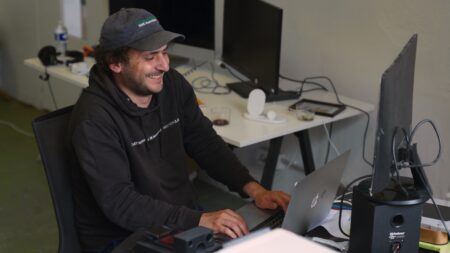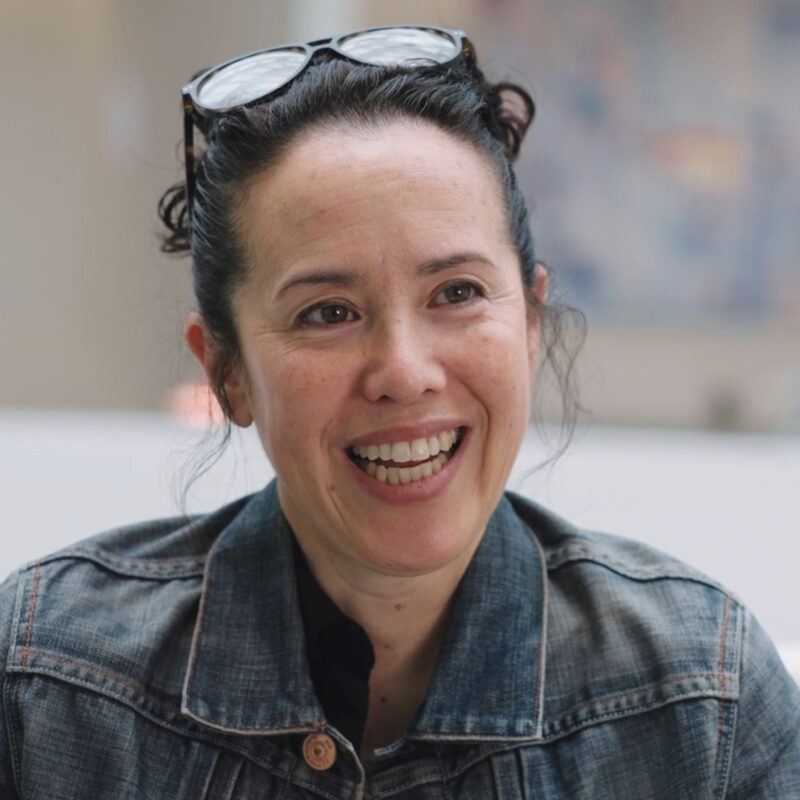Continue playing
(Time remaining: )
Play from beginning
Continue playing "{{ controller.videos[controller.getVideo(controller.currentVideo)].segmentParentTitle}}"
{{controller.videos[controller.getVideo(controller.currentVideo)].title}} has ended.
Emotional TimeSarah Sze
Visit our Awards page for this film’s honors and recognition.
Within the iconic spiraling architecture of New York City’s Guggenheim Museum, a series of projected videos drift along the walls and collide with one another: a peregrine falcon soaring in a clear sky, a tall building collapsing in a cloud of smoke, a finger gently disturbing a pool of blue liquid, and more. Bleeding into the museum walls, Sarah Sze’s River of Images (2023) is one of many site-specific works that call attention to the museum’s unique design in Sze’s 2023 exhibition, Timelapse. Throughout the exhibition, the artist emphasizes how both art and architecture impact one’s experience of the world. Her works play off the Guggenheim’s design, drawing the viewer’s gaze to elements like the immense void at the center of the building or the play of light and shadows created by the bay walls. “This is one of the most radical architectures built.” says Sze, “It’s the air, it’s the light, it’s the tilt. It’s all of these things that really create an entirely new inner world when you enter this museum.”
Through scale, perception, and material, Sze’s works impact the behaviors of museum-goers as they navigate the radical space. Sculptures like Slice (2023), a towering, scaffold-like structure made of mundane objects and photographs, seem on the verge of falling apart, and their apparent fragility instills caution in viewers, while paintings, like Times Zero (2023), dwarf the average human and engulf them in what the artist calls an “interior landscape.” To create Times Zero, the artist uses a mixture of collage and painting, forming a vortex of dripping paint and torn photographs. The photographs depict a variety of scenes, such as a bright orange sunset, a hand reaching toward something, and Sze’s sleeping daughter, amongst many others. Integrating photography into her painting, the artist depicts how the myriad images we encounter daily are integrated into our internal world through memory, drawing a distinction between the external image and its internal counterpart. For Sze, the truth of our memory and measurement of time lies in emotional intensity. “Art is the thing that gives us this way of seeing that,” she says, “it’s the gift of emotional time.”
Credits
Extended Play Series Producer: Ian Forster. Director: Ian Forster. Editor: Thomas Niles. Camera: Jarred Alterman, Sean Hanley, Rafael Salazar Moreno. Sound: Fivel Rothberg. Colorist: Max Blecker. Sound Mix: Collin Blendell. Assistant Editor: Michelle Hanks. Music: Epidemic Sound. Artwork Courtesy: Sarah Sze, Gagosian, Tanya Bonakdar Gallery, Victoria Miro. Special Thanks: Solomon R. Guggenheim Museum.
Extended Play is presented by the Marina Kellen French Foundation, with support from The Andy Warhol Foundation for the Visual Arts, public funds from the New York City Department of Cultural Affairs in partnership with the City Council, the New York State Council on the Arts with the support of the Office of the Governor and the New York State Legislature, the Art21 Contemporary Council, and individual contributors.
Closed captionsAvailable in English, German, Romanian, Italian, Japanese, Korean, Chinese, Italian
Through the Art21 Translation Project, multilingual audiences from around the globe can contribute translations, making Art21 films more accessible worldwide. Translate this video now.
Interested in showing this film in an exhibition or public screening? To license this video please visit Licensing & Reproduction.
Sarah Sze builds her installations and intricate sculptures from the minutiae of everyday life, imbuing mundane materials, marks, and processes with surprising significance. By arranging domestic detritus and office supplies into fantastical miniatures, she builds her works, fractal-like, on an architectural scale. Whether adapting to a site or disrupting the urban fabric, Sze’s patchwork compositions mirror the improvisational quality of cities, balancing whimsy with ecological themes of interconnectivity and sustainability.
“Art can show you how time is marked through emotion like no other medium. Because that’s how we as human beings measure time.”
Sarah Sze

